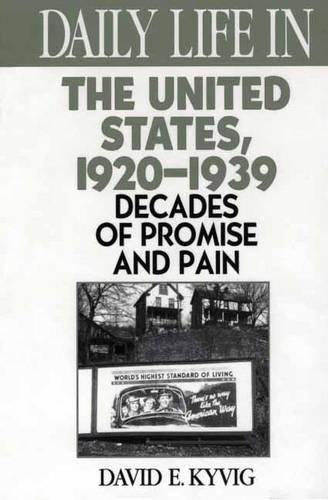
Daily Life in the United States, 1920-1939: Decades of Promise and Pain
(Hardback)
Publishing Details
Daily Life in the United States, 1920-1939: Decades of Promise and Pain
By (Author) David E. Kyvig
Bloomsbury Publishing PLC
Greenwood Press
30th November 2001
United States
Classifications
Tertiary Education
Non Fiction
973.91
Physical Properties
Hardback
288
Width 156mm, Height 235mm
624g
Description
Discover what everyday life was like for ordinary Americans during the decades of development and depression in the 1920s and 1930s. During the 1920s and 1930s, changes in the American population, increasing urbanization, and innovations in technology exerted major influences on the daily lives of ordinary people. Explore how everyday living changed during these years when use of automobiles and home electrification first became commonplace, when radio emerged, and when cinema, with the addition of sound, became broadly popular. Find out how work life, domestic life, and leisure-time activities were affected by these factors as well as by the politics of the time. Details of matters such as the creation of the pickup truck, the development of radio programming, and the first mass use of cosmetics provide an enjoyable read that bring the period clearly into focus. Centering its attention on the broad masses of the population, this animated reference resource emphasizes the wide variety of experiences of people living through "The Roaring Twenties" and "The Great Depression." Readers will be surprised to discover that some of the assumptions we have about the lives of average Americans during these eras are historically inaccurate. A final chapter provides a unique look at six American communities and gives a vivid sense of the diversity of American experience over the course of these tumultuous years.
Reviews
[K]yvig usually achievs a good balance of the descriptive and the analytical. He is particularly good at showing the transforming impact of innovations we have been accustomed to for decades, such as electricity, particularly rural electrification. The text is greatly enhanced by the effective photographs. There are few footnotes, which are generally used only for direct quotations. There is also short, unannotated list of secondary sources for further reading....[i]t is a good introduction for college undergraduates and general readers.-Register of the Kentucky Historical Society
This is a good, kaleidoscopic introduction to how ordinary Americans coped with life in the unusually turbulent decades on the boom-and-bust 1920s and the Great Depression. David Kyvig does a good job of conveying the texture of daily life in the of societal change.-The Register of the Kentucky Historical Society
"Kyvig usually achievs a good balance of the descriptive and the analytical. He is particularly good at showing the transforming impact of innovations we have been accustomed to for decades, such as electricity, particularly rural electrification. The text is greatly enhanced by the effective photographs. There are few footnotes, which are generally used only for direct quotations. There is also short, unannotated list of secondary sources for further reading....it is a good introduction for college undergraduates and general readers."-Register of the Kentucky Historical Society
"This is a good, kaleidoscopic introduction to how ordinary Americans coped with life in the unusually turbulent decades on the boom-and-bust 1920s and the Great Depression. David Kyvig does a good job of conveying the texture of daily life in the of societal change."-The Register of the Kentucky Historical Society
"[K]yvig usually achievs a good balance of the descriptive and the analytical. He is particularly good at showing the transforming impact of innovations we have been accustomed to for decades, such as electricity, particularly rural electrification. The text is greatly enhanced by the effective photographs. There are few footnotes, which are generally used only for direct quotations. There is also short, unannotated list of secondary sources for further reading....[i]t is a good introduction for college undergraduates and general readers."-Register of the Kentucky Historical Society
Author Bio
DAVID E. KYVIG is Presidential Research Professor and Professor of History at Northern Illinois University. He is the author of Explicit and Authentic Acts: Amending the U.S. Constitution (winner of the 1997 Bancroft Prize) and the editor of Unintended Consequences of Constitutional Amendment (2000), Reagan and the World (Praeger, 1990) and New Day/New Deal: A Bibliography of the Great American Depression, 1929-1941 (Greenwood, 1988).
